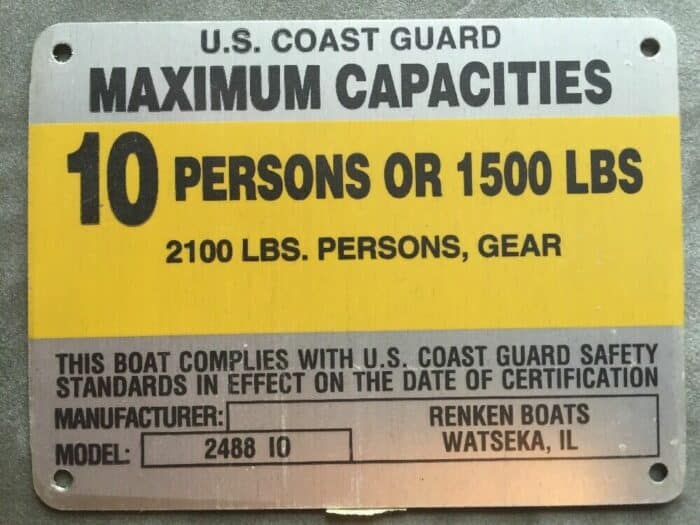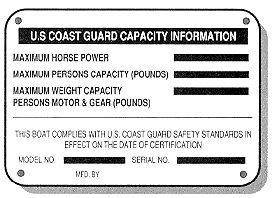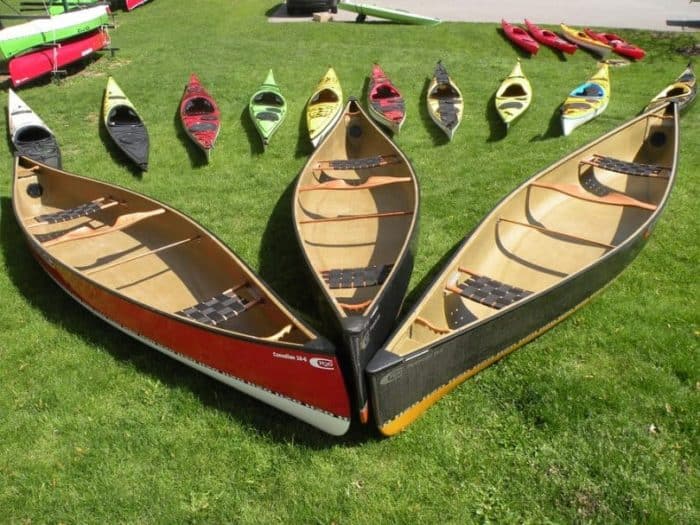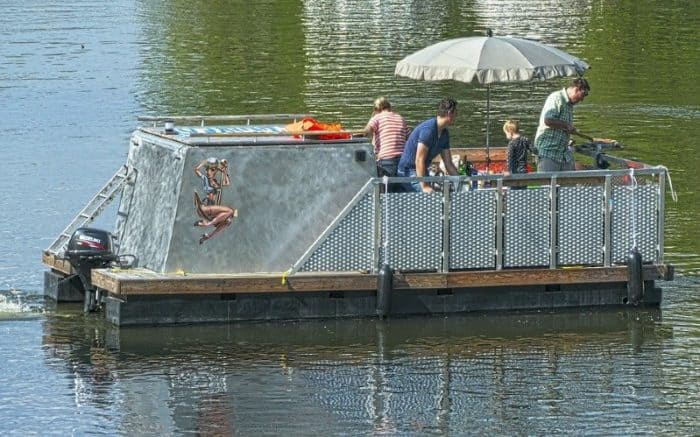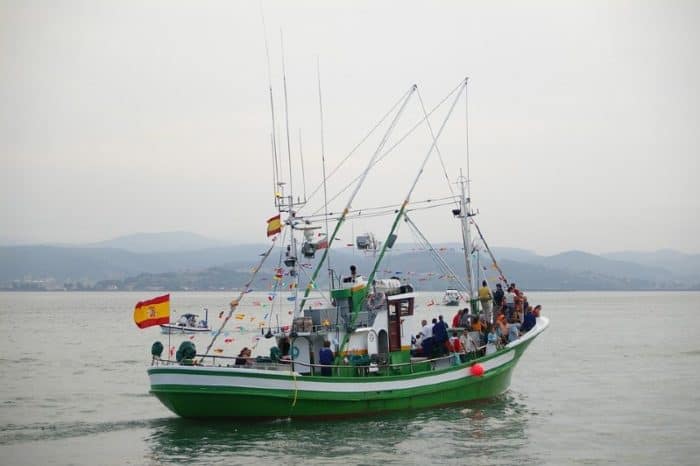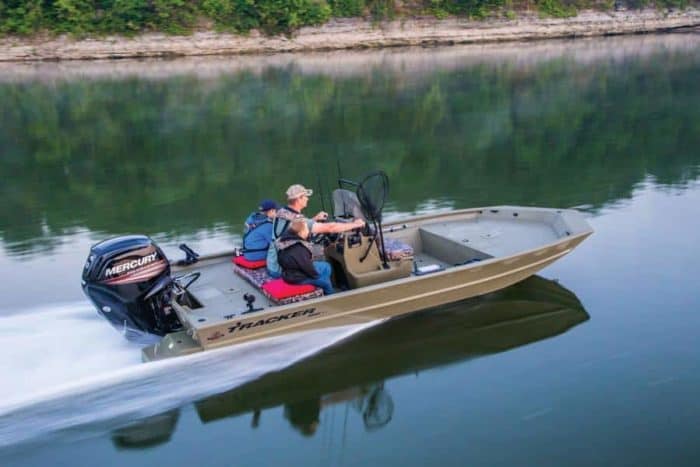What’s the Best Way to Avoid Overloading Your Boat?
The best way to avoid overloading your boat is to have a clear understanding of your boat’s weight capacity and then simply not exceed that capacity. Every boat has either a capacity plate that explains how much weight it can safely hold or an explanation of the same in the owner’s manual. If you have neither an owner’s manual or a capacity plate, contact the manufacturer to determine the precise limits for your specific boat model.
Info on Your Boat’s Capacity Plate
There are two basic kinds of capacity plates you’ll find on a boat. The old style most likely had a red box of information on it. This included the following:
- Maximum horsepower of the boat
- Maximum number of people (in pounds)
- Maximum weight in total (people, gear, fuel, etc)
Information about the manufacturer and model would also be included. This was the old style of capacity plate, however, and boats don’t use these anymore.
New capacity plates, which are actually just decals, feature a bright yellow panel with black lettering. This style details the following:
- Number of people or the maximum weight of those people
- Maximum weight of people plus all gear
- Maximum horsepower of the motor
For this style of plate, the first point will be written out in a format similar to “7 people or 1000 lbs” for example.
Where is the Capacity Plate?
On most boats you’ll find the capacity plate on the transom somewhere. If you’re new to boating, that’s the flat rear portion of the vessel by where the outboard engine would be mounted. It should be plainly visible so if you can’t find one easily it’s probably not back there. This is generally on smaller boats.
If you have a larger boat like a fishing boat, the capacity plate may be located somewhere near where you operate the boat at the boat helm. If there’s a seat for the driver, or some other area from which you control the boat, look around there. Again, these aren’t meant to be hidden or hard to find since this is information you need to know. You are supposed to be able to access this information when you are driving the boat, so keep that in mind.
If it’s not immediately visible, see what’s visible from where you can operate the boat. Some models, although it’s rare, may put the plate on the sides of the boat or even the sides and rear of seats.
What Boats Have Capacity Plates?
If you have a motorized, monohull boat under 20 feet then you are required by federal law to have a capacity plate on board somewhere. This will be true of nearly all boats up to 26 feet, in fact. If a boat is to be certified by the National Marine Manufacturers Association up to 26 feet, they require a capacity plate as well. That said, many boats even over 26 feet will also include capacity plates because National Marine Manufacturers Association members will include them, and that’s the vast majority of boat manufacturers.
One thing to keep in mind is that this is all referring to boats that have motors. You won’t see a capacity plate on manually propelled boats like a canoe, kayak, PWC. Nor will you find them on a sailboat because of this. However, if you are worried about weight capacity for those boats, the manufacturer will likely have included the information in the manual. Failing that, you can contact them directly to ask and you shouldn’t have too much trouble getting to the bottom of things.
A Boat Capacity Formula
In a pinch, there’s a simple equation you can use that will give you a rough estimate of your boat’s passenger capacity, assuming you don’t have a capacity plate or a boat manual on hand.
The number of passengers will be roughly equal to the length of the boat times its width divided by 15.
Passengers = Boat Length X Boat Width/15
So, for example, let’s say you have a 20 foot long boat that’s about 8 feet wide.
Passengers = 20×8/15
Passengers = 160/15
Passengers = approximately 10
This is just a rough idea, of course. You should be checking with the capacity plate to confirm. If your boat does not have a capacity plate but it is supposed to, you could be fined if you’re caught operating without one.
Maximum Passenger Capacity vs Maximum Weight Capacity
Things get a little tricky for some people when they try to determine how they can load a boat based on weight and passenger capacity. You can see this most readily when you compare maximum passenger capacity to max weight capacity. Let’s say your boat is rated for 7 people or 1050 pounds. This is a standard capacity actually because it presumes every person on your boat weighs 150 lbs. But let’s say you and the guys are out fishing and you’re all big fellas. Everyone weighs at least 200 lbs, so your max weight is actually 1,400 lbs. Based on this, if you are following your capacity plate to the letter, you can only have 5 of these people on the boat to stay under 1050 pounds.
Things get a little more complicated when you factor in maximum overall weight. Because that may actually be something like 1,500 lbs. So then you could technically have all 7 people on board and just use less gear, right? Well, no, not really.
The easiest way to reconcile whether to follow maximum passengers or maximum weight is to look at it like this. If the boat is rated for 1050 pounds worth of passenger weight, that could be 7 people who weigh 150 lbs each or two people who weigh 525 lbs each. The maximum weight is the golden number, the maximum passengers is just a rough estimate. Stick to the weight, not the number of people.
What Maximum Capacity Means
The numbers on your capacity plate were determined by the boat manufacturer under ideal circumstances. In choppy and rough waters, things will be a little different, which is why you shouldn’t test your luck. There’s no legal repercussions for not adhering to your capacity plate limits. No one is going to come aboard your boat and weigh your passengers and your gear, but that’s not the point. It’s a matter of safety and you probably shouldn’t want to overload your boat because you’re putting yourself and your passengers at risk if you do so.
Stick to the weight limits that the manufacturer determined because that will allow you to operate your boat in the safest way possible. If you add more people and more weight than is recommended, this will increase the risk of tipping or capsizing the vessel. In addition, overloaded boats are going to put more strain on the engine which will slow you down and waste more fuel.
How to Keep Your Boat Under Weight Limits
If you want to ensure you don’t overload your boat, follow the guidelines of the capacity plate. If the boat is designed for 7 people, don’t try to get an 8th or 9th on board. If it’s intended for 1050 pounds and all of your passengers are larger people, you may have to let fewer of them onto the boat. This is the biggest and easiest way to ensure you never overload your boat. Passengers are, generally speaking, the heaviest things you’re going to bring on board in most cases. That said, there are some other hints and tips that can help you shave off some excess pounds as well if you find your boat too close to tipping the scales.
There are a surprising number of deaths each year attributed to boats being overloaded. This is because many people aren’t aware of or forget what their weight capacity is, and don’t do the calculations to ensure their boat is staying in the safe zone.
Tips for Keeping Your Boat From Overloading
If you feel like you’re at capacity with your boat and worry that you may be a little over or that things could get dicey if bad weather rolls in, try some of these tips to keep things moving smoothly.
Distribute The Weight
You can cause some havoc on a boat even without exceeding weight limits and the passenger limit if all the weight is located in one place. If all ten passengers on a boat stand at the bow, then your bow is probably going to dip, that just makes sense. Make sure you spread the weight evenly across the boat. Gear can be stored to the sides, front and rear, and passengers can sit at the same locations. If you have five people on the boat, make sure someone is at the bow, someone at the stern, someone more central and then maybe the other two to starboard and port. Not only will it make the ride smoother and safer, it’ll be less stressful on your motor as well.
Make sure your passengers have their life vests on as well as being seated in an evenly distributed fashion. This should always be happening but if you’re at all fearful of your boat being overloaded then you definitely want to make sure everyone will be safe if something bad happens.
Secure Heavy Items
Depending on the size of your boat and what gear you have on board, you may want to consider using cargo straps or nets to hold things in place. Heavy loads can be secured centrally to keep the boat stable. This is especially helpful if you hit rough waters. If you can prevent heavy items, especially things like coolers, from sliding around on the deck it will make your trip a lot safer and easier overall.
Choose Your Gear Wisely
There are two kinds of gear that you’re likely to bring on any boat trip. The stuff you need and the stuff you want. Stuff you need may include:
Stuff you want can include things like:
- Fishing gear
- Refreshments
- Games
You never want to sacrifice the essential for a boat trip, so make sure you have what you need to operate the boat both legally and safely first. You should have a checklist for any boat trip to ensure you have all those essential items before heading out. Once you know what you must have with you, you can also weigh it all out so you know, at a minimum, what your essential gear is going to weigh without having to think about it. Fuel weighs about 6lbs per gallon. You can trim down on some of the non-essential items after that if you’re still worried about being too heavy.
Keep Your Boat in Good Repair
A boat in rough shape will suffer more from being overloaded than one that’s in good condition. That means making sure you keep it repaired if any cracks or large dents show up, and also clear. Things like strong algae and barnacle build up can both slow your boat down and weigh it down. On something like a pontoon boat, this could significantly affect the overall performance and put you and your passengers at an increased risk.
Follow the Horsepower Recommendation
The horsepower for a given boat will also be listed on a capacity plate. That may make you scratch your head a bit since how would they know the horsepower of your engine? Well, they don’t, but they know what it should be. If you exceed the maximum horsepower you put your boat at risk as well. A motor that is too powerful and too large can offset the balance of your boat. You can make the transom dip too low or lift the bow too high by hitting speeds that may be more than was intended for your boat. If the weight is not balanced correctly, this could sink or flip the boat as well.
Avoid Rough Seas
The figures listed on a capacity plate are determined under ideal conditions. As the water gets choppier, the situation will get worse. Rough seas will make it harder for your boat to maintain balance and buoyancy. If you are at the absolute limit of your total weight capacity, it will cause the boat to react in a way similar to how an overloaded boat would and put you at greater risk of taking on water, flipping, capsizing and so on. Avoid rough seas and get to shore safely and as quickly as possible when you’re worried about the overall weight of your vessel.
The Bottom Line
With a little bit of pre-planning and an understanding of how to read your boat capacity plate, it should not be too hard to avoid overloading your boat. Always make sure you are staying under the weight limit for passengers, regardless of number, and keep track of how much your gear weighs so you can get a max weight total in your head. Make sure you have even weight distribution even on large boats and make sure nothing heavy is allowed to move around loosely. As always, stay safe and have fun.
Categories: Boats
